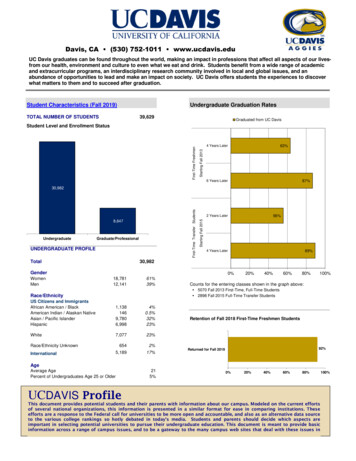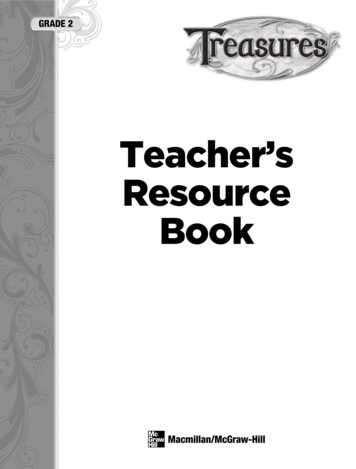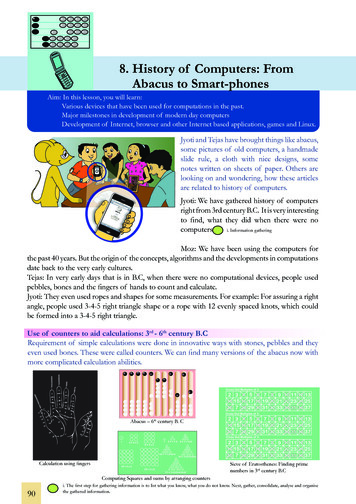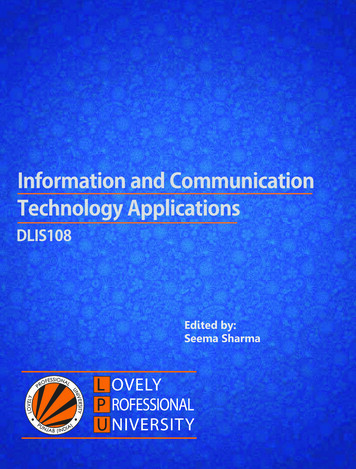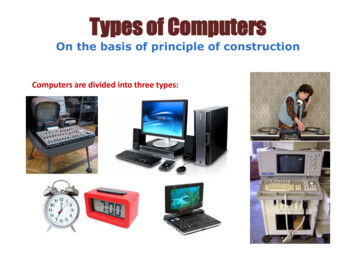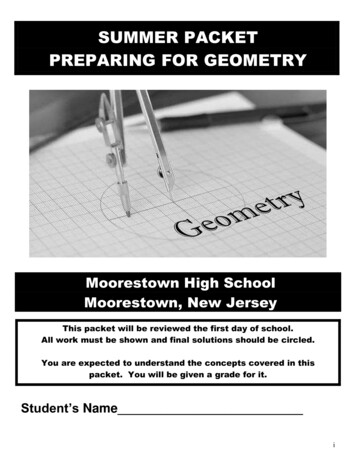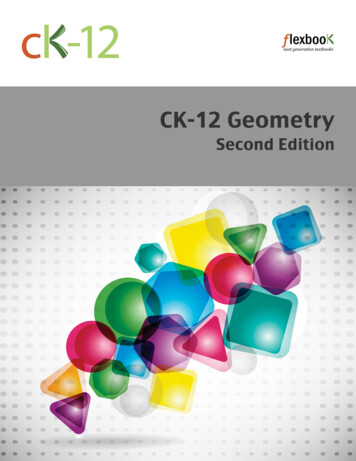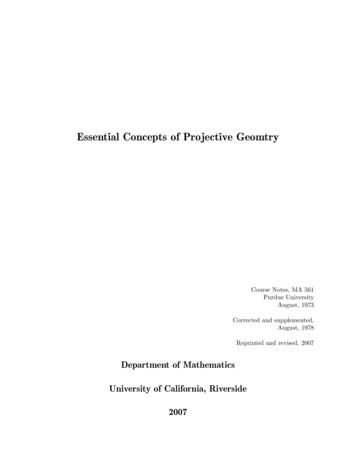
Transcription
GeometrywithComputersComputer-Based Techniques toLearn and TeachEuclidean GeometryTom DavisDraft Date: May 17, 2006
2
Chapter0PrefaceMathematics must be written into the mind, not read into it. “No headfor mathematics” nearly always means “Will not use a pencil.”Arthur Latham Baker0.1 Why Another Geometry Book?Euclidean Geometry is ancient, and thousands of books and articles have been writtenon the subject. Why write another?Here are the differences between this book and the others: Most mathematics books are written to communicate results: theorems, calculation methods and algorithms. This book concentrates on computer-based techniques for solving geometric problems.i
iiPREFACE Although it may not be obvious, mathematics is highly geometrical—virtuallyevery formula has an associated picture. Often it is much easier to obtain understanding by mentally manipulating the picture than by manipulating a formulaalgebraically. What better way to practice mental manipulation of pictures thanto study geometry?Mental manipulation of geometry is difficult for many people, but today almostany relatively new personal computer has graphical capabilities that would havebeen unimaginably powerful 20 years ago. These machines can help visualizegeometric results in a dynamic manner that is far more compelling than the fixeddrawings appearing in standard mathematics books or that can be produced withpencil and paper. This book comes with a computer program called Geometerthat allows you to manipulate existing geometric diagrams and to create yourown. Geometer can also be used as an experimental tool to run geometry “experiments” that can aid greatly in both understanding and proving results. Although Euclidean geometry is a huge field, it is not a big part of the generalmathematics curriculum in the United States. I have a Ph.D. in mathematics,and the only formal class I had in Euclidean geometry was in high school. Yourgeometry class may have been different, but in mine we somehow managed toavoid learning most of the truly beautiful results. High school geometry is often the first introduction students have to constructingmathematical proofs. It is obviously better to begin with simple examples whenteaching a student to write proofs, so the proof construction exercises in typicalhigh school texts can almost all be completed in three or four steps.Unfortunately, if one is limited to proofs of only a few steps, a huge proportion ofgeometry is inaccessible. For people who can follow a ten or twenty step proof,it is amazing what results are accessible—some of the most beautiful theoremsin mathematics.One’s technique of geometric proof can be honed with artificial drills, or one canwork on interesting problems. This is similar to the difference between runningon a treadmill or on mountain trails—the treadmill is completely predictablewhile the trails can be tricky but the trail runner will not be bored out of hismind. This book is aimed at those who did enough treadmill geometry in highschool and want to see some beauty while they learn advanced techniques.The material here is accessible to brighter high school students, and can be usedas supplementary material by teachers or by the students themselves.The Geometer program can also be used as a presentation device in geometryclasses. Although most of the material is beyond what is taught in high school,many of the more important introductory results are available on the enclosedCD in Geometer format.There is additional material on the CD to help—some more elementary theorems, and a tutorial on the construction of sophisticated Geometer diagrams, forexample. See the index file on the CD for up to date information.
0.2. AUDIENCEiii Finally, with computer graphics increasing in power every year, Euclidean geometry (and projective geometry as well) may be destined for a comeback. Moreand more computer applications are being designed to help people visualizeproblems geometrically, but to make the computers do a good job of that, moreknowledge of geometry is required.0.2 AudienceThis book is for teachers of Euclidean geometry but it contains topics of interest formotivated students or anyone who loves geometry. Students and coaches of studentswho compete in high level mathematics competitions should find the advanced materialin this text valuable as training aids.0.3 Origins of GeometerThe I worked at Silicon Graphics for 16 years doing graphics programming and helpingdesign computer graphics hardware and so I have a fairly solid grounding in both thetheoretical and practical details of geometry.Although I was paid money to be a computer engineer, I have never ceased to be amathematician as well. From time to time both in and out of work I ran into interestinggeometric theorems. A couple of them seemed so surprising and non-intuitive that Iwrote computer programs to help me visualize them. After going through that exercisea few times, I realized that it would not be hard to write a general-purpose programwhere arbitrary geometric diagrams could be entered with a graphical user interface(GUI) and dynamically altered. I hacked together the original version of Geometer onSilicon Graphics UNIX machines in my spare time. (I was wrong when I thought it“would not be hard.”)The version of Geometer included with this book is vastly modified and improved(and it now runs on Windows, Macintosh OS X and Linux machines), but much of theunderlying philosophy is the same.As I worked on this book, I tried to practice what I preach. I knew of many interesting results that I had never actually proved, and rather than just look up the standardproofs, I struggled to figure them out myself. Of course from time to time I had to lookin various books for “hints” and even when I did solve a problem completely withouthints, I later read the literature to see what the “standard” methods are.In my struggles to find the proofs, I used Geometer extensively in exactly the sameways I expect you the reader to use it. It may not be bug-free, but I can assure youthat it is quite robust, and since it has been used to create thousands of real dynamicdiagrams, it is fairly well streamlined: when I got annoyed with something, I just fixedit.
PREFACEiv0.4 AcknowledgementsA mathematician is a machine for turning coffee into theorems.Alfréd Rényi1Zvezdelina Stankova showed me many wonderful geometric ideas. In particular, Ilearned from her the power of the technique of inversion in a circle.I would like to thank Joshua Zucker and his students in Palo Alto’s Gunn HighSchool Math Circle for all the stimulating discussions of mathematics problems andfor serving as unwitting guinea pigs for some of the presentation techniques used here.I also learned a lot in Zvezdelina’s UC Berkeley Math Circle, and in Tatiana Shubin’sMath Circle at San Jose State University.Special thanks go to Gerald Alexanderson and Arthur Benjamin for their helpin converting what began as a disorganized collection of half-baked ideas into thecompletely-baked version you hold in your hands. Rudolf Fritsch provided many detailed corrections and suggestions.I received many wonderful suggestions for improvements and enhancements to theGeometer program from Paul Haeberli and Henry Moreton.This book was produced using LATEX, the Emacs editor, and the PostScript filesproduced by Geometer. After an infuriating attempt to use the most popular wordprocessor in the world for the text, Emacs and LATEX were a total pleasure to use, so Imust thank Donald Knuth for writing TEX and Leslie Lamport for writing LATEX.My wife, Ellyn Bush, although not a mathematician, read and re-read many partsof the text, and provided many valuable insights on how to make things simpler andclearer. She put up with all of my complaints with only a few of her own.Finally, as the quotation at the beginning of this section indicates, I would like tothank whoever it was who discovered that beans of the shrub Coffea arabica could beroasted, ground and steeped in boiling water to produce the nectar of life. I convertedthat nectar not only into theorems, but also into text and into the computer code thatproduced Geometer.Tom DavisMay, 20041 Thisresult was sharpened by Pal Turan who added that weak coffee produces only lemmas.
ContentsPrefacei0.1Why Another Geometry Book? . . . . . . . . . . . . . . . . . . . . .i0.2Audience . . . . . . . . . . . . . . . . . . . . . . . . . . . . . . . .iii0.3Origins of Geometer . . . . . . . . . . . . . . . . . . . . . . . . . .iii0.4Acknowledgements . . . . . . . . . . . . . . . . . . . . . . . . . . .iv1 Introduction11.1Computer Geometry Programs . . . . . . . . . . . . . . . . . . . . .21.2The Contents of the CD . . . . . . . . . . . . . . . . . . . . . . . . .31.3Organization of the Book . . . . . . . . . . . . . . . . . . . . . . . .41.4Proofs in this Book . . . . . . . . . . . . . . . . . . . . . . . . . . .71.5Illustrations in this Book . . . . . . . . . . . . . . . . . . . . . . . .71.6How to Use this Book . . . . . . . . . . . . . . . . . . . . . . . . . .91.7Notation . . . . . . . . . . . . . . . . . . . . . . . . . . . . . . . . .101.8Where to Go from Here . . . . . . . . . . . . . . . . . . . . . . . . .112 Computer-Assisted Geometry152.1Accurate Drawings . . . . . . . . . . . . . . . . . . . . . . . . . . .162.2Drawing Manipulation . . . . . . . . . . . . . . . . . . . . . . . . .212.3Finding and Testing Conjectures . . . . . . . . . . . . . . . . . . . .222.4conjecture testing . . . . . . . . . . . . . . . . . . . . . . . . . . . .222.5Ease of Correction . . . . . . . . . . . . . . . . . . . . . . . . . . .242.6Stepping through Proofs . . . . . . . . . . . . . . . . . . . . . . . .242.7Making Measurements . . . . . . . . . . . . . . . . . . . . . . . . .26v
CONTENTSvi2.82.92.102.112.122.132.142.15Searching for Patterns . . . . . . . . .Searching for Extremes . . . . . . . .Locus of Points . . . . . . . . . . . .Computer-Generated Diagrams . . . .Animations . . . . . . . . . . . . . .Drawing for Publication . . . . . . .Computer Algebra Systems . . . . . .Non-Mathematical Uses of Geometer.30323334383940423 Geometric Construction3.1 The Circumcenter . . . . . . . . . . .3.2 Available Tools . . . . . . . . . . . .3.3 The Structure of a Geometer Diagram3.4 Interpreting Geometer Files . . . . .3.5 Simple Classical Examples . . . . . .3.6 Intermediate Examples . . . . . . . .3.7 Advanced Examples . . . . . . . . .3.8 Poncelet’s Theorem Demonstration . .3.9 Seven Tangent Circles . . . . . . . . .3.10 A Tricky Construction . . . . . . . .3.11 Classical Construction . . . . . . . .3.12 Some Constructions Are Impossible .3.13 139 More Problems . . . . . . . . . .3.14 Construction Exercises . . . . . . . 919293959697994 Computer-Aided Proof4.1 Finding the Steps in a Proof .4.2 Testing a Diagram . . . . . .4.3 Altitudes as Bisectors . . . .4.4 Another Bisector . . . . . .4.5 Perpendicular Diagonals . .4.6 Constant Sum . . . . . . . .4.7 Find a Radius . . . . . . . .4.8 Sum of Lengths . . . . . . .4.9 Bisector Bisector . . . . . .4.10 The Simson Line . . . . . .4.11 A Property of Two Cevians .4.12 Tangent Line Problem . . . .4.13 Cyclic Quadrilateral Problem4.14 A Strange Relationship . . .4.15 Sum of Powers . . . . . . .
CONTENTS5 More Useful Theoremsvii1055.1Ceva’s Theorem . . . . . . . . . . . . . . . . . . . . . . . . . . . . . 1055.2Menelaus’ Theorem . . . . . . . . . . . . . . . . . . . . . . . . . . . 1085.3Alternate Proofs of Menelaus and Ceva . . . . . . . . . . . . . . . . 1105.4Using Menelaus’ and Ceva’s Theorem . . . . . . . . . . . . . . . . . 1115.5Ptolemy’s Theorem . . . . . . . . . . . . . . . . . . . . . . . . . . . 1115.6Heron’s Formula . . . . . . . . . . . . . . . . . . . . . . . . . . . . 1135.7The Radical Axis . . . . . . . . . . . . . . . . . . . . . . . . . . . . 1166 Locus of Points1216.1Unknown Geometric Locus . . . . . . . . . . . . . . . . . . . . . . . 1216.2Euler’s Formula . . . . . . . . . . . . . . . . . . . . . . . . . . . . . 1236.3Triangle from Three Medians . . . . . . . . . . . . . . . . . . . . . . 1246.4The Ellipse . . . . . . . . . . . . . . . . . . . . . . . . . . . . . . . 1266.5Locus Construction Exercises . . . . . . . . . . . . . . . . . . . . . . 1276.6Constant Ratio . . . . . . . . . . . . . . . . . . . . . . . . . . . . . 1286.7Higher-Order Curves . . . . . . . . . . . . . . . . . . . . . . . . . . 1296.8Plotting Curves of the Form: y f (x) . . . . . . . . . . . . . . . . . 1326.9Plotting Curves in Polar Coordinates . . . . . . . . . . . . . . . . . . 1336.10 Envelopes of Curves: the Epicycloid . . . . . . . . . . . . . . . . . . 1347 Triangle Centers1377.1General Properties of Triangle Centers . . . . . . . . . . . . . . . . . 1387.2The Gergonne Point . . . . . . . . . . . . . . . . . . . . . . . . . . . 1387.3The Nine Point Center . . . . . . . . . . . . . . . . . . . . . . . . . 1407.4The Fermat Point . . . . . . . . . . . . . . . . . . . . . . . . . . . . 1417.5The Nagel Point . . . . . . . . . . . . . . . . . . . . . . . . . . . . . 1437.6The First Napoleon Point . . . . . . . . . . . . . . . . . . . . . . . . 1447.7The Brocard Points . . . . . . . . . . . . . . . . . . . . . . . . . . . 1467.8The Mittenpunkt . . . . . . . . . . . . . . . . . . . . . . . . . . . . 1497.9A New Center . . . . . . . . . . . . . . . . . . . . . . . . . . . . . . 1517.10 Additional Triangle Centers . . . . . . . . . . . . . . . . . . . . . . . 1527.11 Trilinear Coordinates . . . . . . . . . . . . . . . . . . . . . . . . . . 1537.12 Triangle Center Finder . . . . . . . . . . . . . . . . . . . . . . . . . 1547.13 Searching for the “True” Center of a Triangle . . . . . . . . . . . . . 157
CONTENTSviii8 Inversion in a Circle8.1 Overview of Inversion . . . . . . . . . . . .8.2 Formal Definition of Inversion . . . . . . . .8.3 Simple Properties of Inversion . . . . . . . .8.4 Preservation of Angles Under Inversion . . .8.5 Summary of Inversion in a Circle . . . . . . .8.6 Circle through a Point Tangent to Two Circles8.7 Circle Tangent to Three Circles . . . . . . . .8.8 Ptolemy’s Theorem Revisited . . . . . . . . .8.9 Fermat’s Problem . . . . . . . . . . . . . . .8.10 Inversion to Concentric Circles . . . . . . . .8.11 The Steiner Porism . . . . . . . . . . . . . .8.12 Four Circle Problem . . . . . . . . . . . . .8.13 The Arbelos of Pappus . . . . . . . . . . . .8.14 Another Arbelos Result . . . . . . . . . . . .8.15 The Problems of Apollonius . . . . . . . . .8.16 Peaucellier’s Linkage . . . . . . . . . . . . .8.17 Feuerbach’s Theorem . . . . . . . . . . . . 881899 Projective Geometry9.1 Desargues’ Theorem . . . . . . . . . . .9.2 Projective Geometry . . . . . . . . . . .9.3 Monge’s Theorem . . . . . . . . . . . . .9.4 The Theorem of Pappus . . . . . . . . . .9.5 Another View of Projective Geometry . .9.6 Projective Duality . . . . . . . . . . . . .9.7 Pascal’s Theorem . . . . . . . . . . . . .9.8 Homogeneous (Projective) Coordinates .9.9 Higher Dimensional Projective Geometry9.10 The Equation of a Conic . . . . . . . . .9.11 Finite Projective Planes . . . . . . . . . .19319319519719920120320421021222322410 Harmonic Point Sets10.1 What is an Harmonic Set? . . . . . .10.2 Some Constructions of Harmonic Sets10.3 Harmonic Points and Music . . . . . .10.4 The Complete Quadrilateral . . . . .10.5 Poles and Polars . . . . . . . . . . . .10.6 The Problem of Apollonius (Again) .10.7 Poles and Polars Relative to Conics .227227230232233236240241.
CONTENTS11 Geometric Presentationsix24311.1 General Considerations . . . . . . . . . . . . . . . . . . . . . . . . . 24411.2 Improving the Appearance of a Diagram . . . . . . . . . . . . . . . . 24511.3 Building Geometer Proofs and Constructions . . . . . . . . . . . . . 24711.4 Some Final Touches . . . . . . . . . . . . . . . . . . . . . . . . . . . 25211.5 Calculation in Geometer . . . . . . . . . . . . . . . . . . . . . . . . 25411.6 Using Geometric Transformations . . . . . . . . . . . . . . . . . . . 25911.7 Constructing Geometer Scripts . . . . . . . . . . . . . . . . . . . . . 26111.8 Scripts and Layer Conditionals . . . . . . . . . . . . . . . . . . . . . 27011.9 Computer-Generated Diagrams . . . . . . . . . . . . . . . . . . . . . 27112 Geometer Proofs27912.1 Illustrated Theorems . . . . . . . . . . . . . . . . . . . . . . . . . . 28012.2 Proof Exercises . . . . . . . . . . . . . . . . . . . . . . . . . . . . . 284A Mathematics Review293A.1 Types of Geometric Problems . . . . . . . . . . . . . . . . . . . . . . 294A.2 Congruence . . . . . . . . . . . . . . . . . . . . . . . . . . . . . . . 294A.3 Points . . . . . . . . . . . . . . . . . . . . . . . . . . . . . . . . . . 299A.4 Lines . . . . . . . . . . . . . . . . . . . . . . . . . . . . . . . . . . 299A.5 Angles . . . . . . . . . . . . . . . . . . . . . . . . . . . . . . . . . . 302A.6 Triangles . . . . . . . . . . . . . . . . . . . . . . . . . . . . . . . . 304A.7 Quadrilaterals . . . . . . . . . . . . . . . . . . . . . . . . . . . . . . 316A.8 General Polygons . . . . . . . . . . . . . . . . . . . . . . . . . . . . 319A.9 Circles . . . . . . . . . . . . . . . . . . . . . . . . . . . . . . . . . . 323A.10 Trigonometric Definitions . . . . . . . . . . . . . . . . . . . . . . . . 327A.11 Coordinate Geometry . . . . . . . . . . . . . . . . . . . . . . . . . . 336A.12 Vectors . . . . . . . . . . . . . . . . . . . . . . . . . . . . . . . . . 342A.13 Complex Numbers . . . . . . . . . . . . . . . . . . . . . . . . . . . 351B Geometer Art355
CONTENTSxC Geometric Problem Solving Strategies359C.1 Congruence . . . . . . . . . . . . . . . . . . . . . . . . . . . . . . . 361C.2 Similarity . . . . . . . . . . . . . . . . . . . . . . . . . . . . . . . . 362C.3 Special Figures . . . . . . . . . . . . . . . . . . . . . . . . . . . . . 362C.4 Concurrence . . . . . . . . . . . . . . . . . . . . . . . . . . . . . . . 363C.5 Measures . . . . . . . . . . . . . . . . . . . . . . . . . . . . . . . . 364C.6 Equality and Inequality . . . . . . . . . . . . . . . . . . . . . . . . . 366C.7 Ratios . . . . . . . . . . . . . . . . . . . . . . . . . . . . . . . . . . 366C.8 Inversion in a Circle . . . . . . . . . . . . . . . . . . . . . . . . . . . 367C.9 Algebraic Manipulation . . . . . . . . . . . . . . . . . . . . . . . . . 368C.10 When to Draw the Line . . . . . . . . . . . . . . . . . . . . . . . . . 369C.11 Construction Techniques . . . . . . . . . . . . . . . . . . . . . . . . 370C.12 Relabeling . . . . . . . . . . . . . . . . . . . . . . . . . . . . . . . . 371C.13 General Problem Solving Approaches . . . . . . . . . . . . . . . . . 371
Chapter1IntroductionThis book describes techniques and strategies that use computer software to enhancethe study of geometry. If you are itching to try the Geometer program on the enclosedCD, that is as good a way to start as any. Install the program and go directly to thetutorial which you will find under the Help pulldown menu.The Geometer program upon which this book is based is freely available and inthe public domain. Anyone may obtain a copy at:http://www.geometer.org/geometerYou may already be proficient in the use of one of the commercial computer geometry programs such as Geometer’s Sketchpad , Cabri Geometry , Cinderella orothers, and if so, almost all the techniques described here can be applied using thosepackages.The main advantage of Geometer is that the included CD containscomputer-readable versions of all the examples and figures in this book in Geometerformat.1
2CHAPTER 1. INTRODUCTIONThis book is for anyone who wants to learn about computer methods to enhance thestudy of geometry, be they students or teachers of the subject. The term “student” refersto anyone who is studying geometry—either as part of a formal course or simply forthe love of the subject. The text does assume a high school mathematics background,but Appendix A reviews all the important prerequisites.The purpose of this book is to demonstrate techniques, not theorems. Althoughas far as possible interesting theorems have been chosen for the demonstrations, noattempt has been made to assure that the list of theorems presented is complete in anysense. While it is true that the text material combined with the additional exampleson the CD does cover a large number of theorems, please do not feel slighted if yourfavorite theorem does not appear.1.1 Computer Geometry ProgramsA computer geometry program is a computer program with a graphical user interfacethat allows you to draw geometric objects and to adjust them dynamically. Such systems are constraint-based in that most of the objects in a figure are not placed absolutely, but are defined in terms of the positions of other objects on the screen. Forexample, your drawing may contain two freely movable points and a third point that istheir midpoint. In most computer geometry programs you can freely adjust the positions of the first two points, but not the third. If you do adjust either of the first points,however, the position of third point will change so that it remains at their midpoint.The constraints in such a system can be nested arbitrarily deeply. For example, aline passing through the midpoint described in the previous paragraph will also movewhen the midpoint moves, but the midpoint can only move if one of the two originalpoints is moved, and so on.This book demonstrates many things that computer geometry programs can do, butit is equally important to be aware of what they cannot do.Such programs do provide accurate drawings. They allow you to visualize not justone example of a drawing, but thousands of variations. They allow you to test geometric conjectures, and can present dynamic illustrations of relationships or theorems.What they cannot do (at least as of the publication date) is to generate proofs oftheorems. In order for a theorem to be accepted as true, a formal proof is required, andalthough computer geometry programs can help you to find that proof, it is you whowill have to provide the completed version.The more geometry you know, the more helpful a computer can be. If you havedrawn a diagram and see in it a relationship that you would like to prove, it may be thatthe computer can discover other relationships in the diagram that you did not noticeand that may help you construct a proof. But it will be up to you to discover how touse that information to produce a formal proof.For example, imagine that you are trying to show that three circles in a diagrammeet at a point. When you allow the computer to examine the diagram, suppose itnotices that a certain set of four seemingly unrelated points are concyclic (“concyclic”
1.2. THE CONTENTS OF THE CD3means that they all lie on the same circle). This unlikely occurrence is easy for acomputer to recognize, but usually difficult for a human, and it could easily be relatedto your three circle concurrence problem. But even if knowing that the points areconcyclic makes your result obvious, you still need to show that the four points are, infact, concyclic. It is clear that the more ways you know to prove that four points lie onthe same circle, the easier your task will be. (If you’re interested in what such a listmight look like, see item 15 in Section 1.3.)Another obvious limitation of computers is due to round-off error in their calculations. It should not surprise you if a computer indicates that a certain right trianglehas sides of lengths 3, 4, and 5.0000001, although any student of high school geometry knows that this cannot be true. Thus some common sense is required. If you areasked to find an unknown length, and the computer measures it as 7.000013, you willprobably have a lot more luck if you try to prove that it is 7, not 7.000013. If, however,the computer says the length is 7.071907, it is probablynot equal to 7. If you are very good, you may notice how close 7.071907 is to 50—knowledge is power.1.2 The Contents of the CDThe enclosed CD contains a copy of the public-domain computer geometry programcalled “Geometer” that runs on Windows and Linux machines as well as on Macintoshsystems running OS X. All the illustrations in this text were prepared with Geometer.See Section 1.5 for details about how to interpret the captions on the figures. TheGeometer CD includes: The Geometer program itself. A tutorial and user’s guide for the program. The source files for all the examples in the user’s guide and tutorial. The source files for all the illustrations in this book. Solutions to all the exercises in this book in the form of Geometer files (calledGeometer diagrams). Many additional files of interesting geometric results not covered in this book.The Geometer program can be used at many levels, depending on how much youwant to learn about it. See Chapter 2 for a much more detailed description of whatGeometer (and programs like it) can do. To view a diagram in this text simply double-click the corresponding Geometerfile on the CD. To manipulate the figure, place the cursor over a point and press down the mousebutton. Then until you release the button, the point will be dragged with thecursor, and the figure will be modified appropriately.
CHAPTER 1. INTRODUCTION4 Some Geometer diagrams are “proofs”. The author of the proof organized thediagram so that you can step forward and back through the proof using the Start,Next and Prev (previous) buttons. At each stage during the proof, the figure canbe manipulated as described above. Still other Geometer diagrams are scripts, in which case the Script button will besolidly drawn. If you click on this button with the mouse, the diagram will passthrough a prearranged script. Sometimes you can manipulate the figure beforepressing the Script button to observe the consequences of the script with differentinitial configurations. Using the mouse buttons and menus you can construct and save your own simpleGeometer diagrams to test conjectures and to search for patterns and geometricrelationships. In addition to manipulation with the mouse using a graphical user interface, Geometer diagrams have a textual form that can be edited either within Geometeror using your favorite text editor. Using this technique, all the features are available, including designing your own scripts or proofs.1.3 Organization of the BookHere is the basic organization of the rest of the book:1. IntroductionWhat you are reading now.2. Computer-Assisted GeometryThis chapter consists of a quick survey (with examples) of almost every possibleuse for a computer geometry program.3. Geometric ConstructionsTo be able to use a computer geometry program, you have to know how toconstruct diagrams that correspond to the problems you are investigating. Thischapter describes with many examples methods to construct computer diagrams.Classic straightedge and compass constructions are described and discussed, butmost of the emphasis is on how to use the more powerful techniques available incomputer geometry programs, Geometer in particular.At the end of the chapter is a list of construction exercises whose solutions appearin Geometer files on the CD.4. Computer-Aided ProofThis chapter describes how to use your computer to help you search for a proofof a geometric theorem.
1.3. ORGANIZATION OF THE BOOK55. More Useful TheoremsHere are a few useful theorems and their proofs that are not typically coveredin a high school course. When possible, Geometer will be used as an aid tofind those proofs. The results in this chapter plus those in the review appendixprovide all the classical tools needed to solve the rest of the problems in the book.6. Locus of PointsComputer geometry programs make the search for “locus of a point” problemsalmost trivial. In this chapter we will examine some nice examples.7. Triangle CentersThe centroid, circumcenter, incenter and orthocenter are four well-known classical triangle centers, but there are hundreds of others. This chapter examinessome of them.8. Inversion in a CircleThe technique of inversion in a circle is described, with and without computergeometry programs. Applications of this technique to geometric construction areaddressed.9. Projective GeometryGeometer and probably most other computer geometry programs do many oftheir calculations using projective geometry rather than Euclidean geometry. Inaddition, much of computer graphics is based upon projective geometry. Thischapter presents the fundamental concepts of projective geometry, but from a Euclidean point of view. Calculations in homogeneous coordinates are described.10. Harmonic Point SetsThis i
May 17, 2006 · High school geometry is often the rst introductionstudents have to constructing mathematical proofs. It is obviously better to begin with simple examples when teaching a student to write proofs, so the proof construction exercises in typical high school texts can almost all be completed in th
